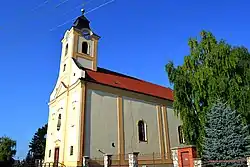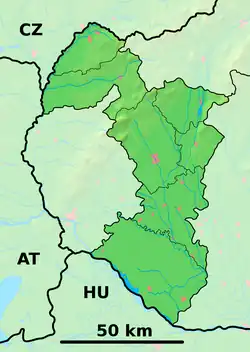Brestovany
Brestovany (Hungarian: Bresztovány) is a municipality with about 2000 inhabitants of Trnava District in the Trnava region of Slovakia. The name of the village may be derived from brest, the Slovak word for elm, a tree which used to be common in the area.[4]
Brestovany | |
|---|---|
Municipality | |
 Church of Saint John the Baptist | |
 Brestovany Location of Brestovany in the Trnava Region  Brestovany Brestovany (Slovakia) | |
| Coordinates: 48°23′N 17°41′E | |
| Country | Slovakia |
| Region | Trnava |
| District | Trnava |
| First mentioned | 1113 |
| Area | |
| • Total | 16.36[1] km2 (6.32[1] sq mi) |
| Elevation | 136[2] m (446[2] ft) |
| Population (2021) | |
| • Total | 2,594[3] |
| Postal code | 919 27[2] |
| Area code | +421 33[2] |
| Car plate | TT |
| Website | brestovany.sk |
History
Brestovany was first mentioned in a document called Zoborská listina from 1113, where it is referred-to as Bristem. In 1241 the village had to face an invasion of Tatars. Another difficulty came in 1271 when the Czech army conquered Trnava and its surrounding for some time. Brestovany became hereditary property of the town Trnava as of 1280, rendering its inhabitants serfs till the 1848 abolition of serfdom. In 1533 the village was invaded by the Ottoman empire, who plundered and burned it to the ground. In the 18th century the Chapel of Saint Martin and the Church of Saint John the Baptist were built there. In 1811 and 1818 fires seriously destroyed large parts of the village.[5] As of 1824 Brestovany belonged to Polish count Jozef Saryusz Zamoyski, who had built a neoclassical mansion there, which now houses a primary school. Later it belonged to another Polish noble, Albert Wielopolski. Both noblemen are buried at the local cemetery.
Archaeology
In July 2022, archaeologists from the Monuments Board of Trnava and the Western Slovakia Museum announced the discovery of a 4,000-year-old female grave. The skeleton was found in a curled position on her left side with jewels from the Early Bronze Age Nitra culture containing two willow-shaped earrings, bone beads, a copper bracelet.[6]
Culture and social life
There are several remarkable historic buildings in Brestovany: the baroque Chapel of Saint Martin (1767), the baroque Church of Saint John the Baptist (1772) and the neoclassical manor house with a large park built in 1826. The village's organizations include a hunters' association, a carrier-pigeon breeders society, a volunteer fire brigade, a sport club and several choirs.
Notable residents
Ľudmila Zamoyska-Gizická (1829 – 1889)– music composer, pianist
Jožo Nižnánsky (1903 – 1976) – writer, journalist, publicist, author of novel Čachtická pani (1932)
František Nižnánsky (1911- 1967) – Brother of Jožo Nižnánsky, one of founders of modern veterinary science in Slovakia
František Hrušovský (1903 – 1956) – historian, publicist
References
- "Hustota obyvateľstva - obce [om7014rr_ukaz: Rozloha (Štvorcový meter)]". www.statistics.sk (in Slovak). Statistical Office of the Slovak Republic. 2022-03-31. Retrieved 2022-03-31.
- "Základná charakteristika". www.statistics.sk (in Slovak). Statistical Office of the Slovak Republic. 2015-04-17. Retrieved 2022-03-31.
- "Počet obyvateľov podľa pohlavia - obce (ročne)". www.statistics.sk (in Slovak). Statistical Office of the Slovak Republic. 2022-03-31. Retrieved 2022-03-31.
- "Brestovany homepage".
- "Brestovany homepage".
- a.s, Petit Press (2022-07-11). "Ancient grave found right under kindergarten". spectator.sme.sk. Retrieved 2022-08-04.
Genealogical resources
The records for genealogical research are available at the state archive "Statny Archiv in Bratislava, Slovakia"
- Roman Catholic church records (births/marriages/deaths): 1711-1897 (parish A)
- Lutheran church records (births/marriages/deaths): 1666-1895 (parish B)